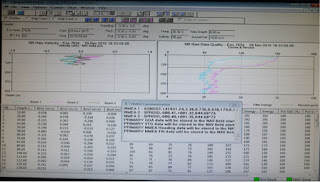Shenjie (or Jason)
gives us a summary of what he has been spending a lot of time working on during
this cruise. In addition to helping with completing logsheets during mooring
recoveries and deployments and detaching and downloading instruments from the CTD
frame in the small hours he has been in charge of processing data on the
currents measured beneath the ship as we steam along.
Shenjie Zhou – what I have been working on
RAPID cruise dy039 is
the very first official research cruise that I have ever joined in my whole
life. The RRS Discovery sailed from Southampton on the 17 October 2015, heading
to Tenerife for our first clearance (and a little maintenance). After Tenerife, we started our journey deep
into the subtropical Atlantic Ocean to recover the RAPID moorings deployed 18
months ago and deploy new ones. Every mooring consists of a beacon and light
for emergency recovery, glass floats providing enough buoyancy for the moorings
to keep all sensors at their designed depth working properly, MicroCAT (CTD)
sensors, different models of current meters and acoustic releases at the bottom
of each mooring attached with anchors.
Meanwhile, two
vessel-mounted Acoustic Doppler Current Profilers (vmadcp) are working
constantly to record the horizontal velocities of the ocean current flowing
below the ship. These two vmadcps are mounted on the starboard side on the
fore-bottom of the ship.
The coordinates below each sensor are
referenced to the centre of the ship. Two instruments work on different frequencies;
75 kHz and 150 kHz. The former has a better penetration into the water to
around 700m depth while the latter one reaches a shallower depth (400m) with
an improved vertical resolution. Four beams are launched from the transducers
with a beam angle of 30º.
Data measured by
vmadcps are recorded via the vessel-mounted Data Acquisition System (VmDas)
software installed on two PCs in the main laboratory. The recording is stopped everyday for the
software to make a copy of the recorded data onto the ship server for daily
processing. Every time the software is restarted, a new sequence will be
created as a tracker on this routine event. All the operations and commands
made on the PCs in main lab will be sent the deck unit of the vmadcp system. These boxes then send signals to the transducer to execute the commands
from the PC terminals. The top one is for the 75 kHz instrument and middle one
is for 150 kHz, the bottom one is a backup for 75 kHz.
 | |
| A typical view of the screen of the PCs controlling the ADCP measurements |
The measurements from
vmadcps when in deep water are calibrated during processing from the bottom
track data collected during shallow water transits. Bottom track is basically
to measure the heading (position) and speed of the centre of the ship as
measured by the ADCP when referenced to the sea floor. It provides the correction
estimates on the amplitude and angle for the vmadcp measurements when the
bottom cannot be “seen” within the range of the instrument. Constrained by the maximum bottom track range,
bottom track mode can only be working functionally in shallow waters (within
the maximum range and also depending on the setup for each instrument).
 |
| The ADCP deck units |
Apart from the
vessel-mounted ADCPs, we also deployed one moored-version ADCP with
one of our moorings at the normal offshore extent of the Deep Western Boundary
Current (WB4) to collect currents data above the mooring which otherwise would
be missing when the mooring is knocked down in strong currents. Two more are
deployed at the continental shelf-edge (WBADCP) to measure the currents inshore
of WB1.
 |
| A self logging version of an ADCP being prepared for deployment before being mounted in a float |

































